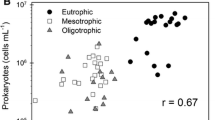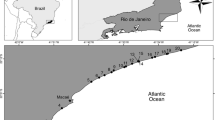Abstract
This study presents a depth-related survey of virioplankton abundance in Lake Pavin (Massif Central, France), in relation to the abundances of heterotrophic prokaryotes, picocyanobacteria (Pcy), autotrophic picoeukaryotes (Peu), and of autotrophic (ANF) and heterotrophic (HNF) nanoflagellates. The sampling strategy was designed to be representative of the physico-chemical gradients of the whole water column of the lake, and the seasonal variability as well. In mixolimnic surface waters, all communities were present and viral abundance peaked in summer and autumn. Viral abundance was significantly correlated (p < 0.001) with Pcy, Peu, and ANF, indicating that cyanophages and perhaps other phytoplankton viruses represent a significant pool of viral standing stocks in the mixolimnion of Lake Pavin. Microautotrophs were absent in the deep monimolimnic water masses, where viruses and heterotrophic prokaryotes exhibited highest seasonal abundances in summer and/or autumn and were significantly correlated (p < 0.001) to each other. This indicates that the anoxic monimolimnion of Lake Pavin is an exclusive habitat for viruses and heterotrophic prokaryotes. We conclude that in this habitat, host availability is prevalent over other factors (temperature, oxygen, nutrients, grazers) in favoring viral proliferation.



Similar content being viewed by others
References
Aeschbach-Hertig W, Hofer M, Schmid M, Kipfer R, Imboden DM (2002) The physical structure and dynamics of a deep, meromictic crater lake (Lac Pavin, France). Hydrobiologia 487:111–136
Amblard C, Bourdier G (1990) The spring bloom of the diatom Melosira italica spp. subarctica in Lake Pavin: biochemical, energetic and metabolic aspects during sedimentation. J. Plankton Res 12:645–660
Bettarel Y, Dolan JR, Hornak K, Lemée R, Masin M, Pedrotti ML, Rochelle-Newall E, Šimek K, Sime-Ngando T (2002) Strong, weak, and missing links in a microbial community of the N.W. Mediterranean Sea. FEMS Microbiol Ecol 42:451–462
Bettarel Y, Sime-Ngando T, Amblard C, Carrias J-F, Portelli C (2003) Virioplankton and microbial communities in aquatic systems : a seasonal study in two lakes of different trophy. Freshwater Biol 48:810–822
Bettarel Y, Sime-Ngando T, Bouvy M, Arfi R, Amblard C (2005) Low consumption of virus-sized particles by heterotrophic nanoflagellates in two lakes of the French Massif Central. Aquat Microb Ecol 39:205–209
Brum JR, Steward GF, Jiang SC, Jellison R (2005) Spatial and temporal variability of prokaryotes, viruses, and viral infections of prokaryotes in an alkaline, hypersaline lake. Aquat Microb Ecol 41:247–260
Carrias JF, Amblard C, Bourdier G (1996) Protistan bacterivory in an oligomesotrophic lake: importance of attached ciliates and flagellates. Microb Ecol 31:249–268
Carrias JF, Amblard C, Quiblier-Lloberas C, Bourdier G (1998) Seasonal dynamics of free and attached heterotrophic nanoflagellates in an oligomesotrophic lake. Freshwater Biol 39:101–111
Carrias JF, Amblard C, Bourdier G (1998) Seasonal dynamics and vertical distribution of planktonic ciliates and their relationships to microbial food resources in the oligomesotrophic Lake Pavin. Arch Hydrobiol 143:227–255
Cochlan WP, Wilkner J, Steward GF, Smith DC, Azam F (1993) Spatial distribution of viruses, bacteria and chlorophyll a in nerictic, oceanic and estuarine environments. Mar Ecol Prog Ser 92:77–87
Colombet J, Sime-Ngando T, Cauchie HM, Fonty G, Hoffman L, Demeure G (2006) Depth-related gradients of viral activity in Lake Pavin. Appl Environ Microbiol 72:4440–4445
Daffonchio D, Sara Borin S, Brusa T, Brusetti L, Van Der Wielen PW, Bolhuis H, Yakimov MM, D’Auria G, Giuliano L, Marty D, Tamburini C, McGenity TJ, Hallsworth JE, Sass AM, Timmis KN, Tselepides A, De Lange GJ, Hübner A, Thomson J, Varnavas SP, Gasparoni F, Gerber HW, Malinverno E, Corselli C & The Biodeep Scientific Party (2006) Stratified prokaryote network in the oxic–anoxic transition of a deep-sea halocline. Nature 440:203–207
Dorigo U, Jacquet S, Humbert JF (2004) Cyanophage diversity, inferred from g20 gene analyses, in the largest natural lake in France, Lake Bourget. Appl Environ Microbiol 70:1017–1022
Drake LA, Choi KH, Haskell AGE, Dobbs FC (1998) Vertical profiles of virus-like particles and bacteria in the water column and sediments of Chesapeake Bay, USA. Aquat Microb Ecol 16:17–25
Fenchel T, Finlay BJ (1994) The evolution of life without oxygen. Am Sci 82:22–29
Hara S, Terauchi K, Koike I (1991) Abundance of viruses in marine waters: assessment by epifluorescence and transmission electron microscopy. Appl Environ Microbiol 57:2731–2734
Hennes KP, Simon M (1995) Significance of bacteriophages for controlling bacterioplankton growth in a mesotrophic lake. Appl Environ Microbiol 61:333–340
Jacquet S, Heldal M, Iglesias-Rodriguez D, Larsen A, Wilson W, Bratbak G (2002) Flow cytometric analysis of an Emiliana huxleyi bloom terminated by viral infection. Aquat Microb Ecol 27:111–124
Karl DM (2002) Nutrient dynamics in the deep blue sea. Trends Microbiol 10:410–418
Lefèvre E, Bardot C, Noël C, Carrias JF, Viscogliosi E, Amblard C, Sime-Ngando T (2007) Unveiling fungal zooflagellates as members of freshwater picoeukaryotes: evidence from a molecular diversity study in a deep meromictic lake. Environ Microbiol 9:61–71
Lehours AC, Bardot C, Thenot A, Debroas D, Fonty G (2005) Anaerobic microbial communities in Lake Pavin, a unique meromictic lake in France. Appl Environ Microbiol 71:7389–7400
Magagnini M, Corinaldesi C, Monticelli LS, De Domenico E, Danovaro R (2007) Viral abundance and distribution in mesopelagic and bathypelagic waters of the Mediterranean Sea. Deep-Sea Res I 54:1209–1220
Maranger R, Bird DF (1996) High concentrations of viruses in the sediments of Lac Gilbert, Québec. Microb Ecol 31:141–151
Massana R, del Campo J, Dinter C, Sommaruga R (2007) Crash of a population of the marine heterotrophic flagellate Cafeteria roenbergensis by viral infection. Environ Microbiol 9:2660–2669
Minic Z, Serre V, Herve G (2006) Adaptation of organisms to extreme conditions of deep-sea hydrothermal vents. Comptes Rendus Biologiques 329:527–540
Nagasaki K, Ando M, Imai I, Itakura S, Ishida Y (1993) Virus-like particles in an apochlorotic flagellate in Hiroshima Bay, Japan. Mar Ecol Prog Ser 96:307–310
Noble RT, Fuhrman JA (1998) Use of SYBR Green I for rapid epifluorescence counts of marine viruses and bacteria. Aquat Microb Ecol 14:113–118
Ortmann AC, Suttle CA (2005) High abundance of viruses in a deep-sea hydrothermal vent system indicates viral mediated microbial mortality. Deep-Sea Res I 52:1515–1527
Pourriot R, Meybeck M (1995) Zonation physisque, chimique et écologique dans les lacs. In : Masson (eds), Limnologie générale. Paris, 956 pp.
Pradeep Ram AS, Boucher D, Sime-Ngando T, Debroas D, Romagoux JC (2005) Phage bacteriolysis, protistan bacterivory potential, and bacterial production in a freshwater reservoir: coupling with temperature. Microb Ecol 50:64–72
Pradeep Ram AS, Sime-Ngando T (2008) Functional responses of prokaryotes and viruses to grazers effects and nutrient additions in freshwater microcosms. The ISME Journal 2:498–509
SCOR-UNESCO (1966) Determination of photosynthetic pigments in sea water. UNESCO, Paris, pp 1–69
Sime-Ngando T, Pradeep Ram AS (2005) Grazer effects on prokaryotes and viruses in a freshwater microcosm experiment. Aquat Microb Ecol 41:115–124
Steward GF, Smith DC, Azam F (1996) Abundance and production of bacteria and viruses in the Bering and Chukchi Sea. Mar Ecol Prog Ser 131:287–300
Suttle CA (2007) Marine viruses—major players in the global ecosystem. Nature Reviews 5:801–812
Tanaka T, Rassoulzadegan F (2002) Full-depth profile (0–2000 m) of bacteria, heterotrophic nanoflagellates and ciliates in NW Mediterranean Sea: vertical partitioning of microbial trophic structures. Deep-Sea Res II 49:2093–2107
Tanaka T, Rassoulzadegan F (2004) Vertical and seasonal variations of bacterial abundance and production in the mesopelagic layer of the NW Mediterranean Sea: bottom-up and top-down controls. Deep-Sea Res I 51:531–544
Tanaka T, Rassoulzadegan F, Thingstad TF (2005) Quantifying the structure of the mesopelagic microbial loop from observed depth profiles of bacteria and protozoa. Biogeosciences Discussions 1:413–428
Tarutani K, Nagasaki K, Yamaguchi M (2000) Viral impacts on total abundance and clonal composition of the harmful bloom-forming phytoplankton Heterosigma akashiwo. Appl Environ Microbiol 66:4916–4920
Taylor GT, Hein C, Iabichella M (2003) Temporal variations in viral distributions in the anoxic Cariaco Basin. Aquat Microb Ecol 30:103–116
Tuomi P, Torsvik T, Heldal M, Bratbak G (1997) Bacterial population dynamics in a meromictic lake. Appl Environ Microbiol 63:2181–2188
Van der Wielen PW, Bolhuis H, Borin S, Daffonchio D, Corselli C, Giuliano L, D’Auria G, De Lange GJ, Huebner A, Varnavas SP, Thomson J, Tamburini C, Marty D, McGenity TJ, Timmis KN, Party BioDeep Scientific (2005) The enigma of prokaryotic life in deep hypersaline anoxic basins. Science 307:121–123
Vezzi A, Campanaro S, D’Angelo M, Simonato F, Vitulo N, Lauro FM, Cestaro A, Malacrida G, Simionati B, Cannata N, Romualdi C, Bartlett DH, Valle G (2005) Life at depth: photobacterium profundum genome sequence and expression analysis. Science 307:1459–1461
Weinbauer MG (2004) Ecology of prokaryotic viruses. FEMS Microbiol Rev 28:127–181
Weinbauer MG, Fuks D, Puskaric S, Peduzzi P (1995) Diel, seasonal, and depth-related variability of viruses and dissolved DNA in the Northern Adriatic Sea. Microb Ecol 30:25–41
Weinbauer MG, Höfle MG (1998) Significance of viral lysis and flagellate grazing as factors controlling bacterioplankton production in a eutrophic lake. Appl Environ Microbiol 64:431–438
Weinbauer MG, Hornàk K, Jezbera J, Nedoma J, Dolan JR, Šimek K (2007) Synergistic and antagonistic effects of viral lysis and protistan grazing on bacterial biomass, production and diversity. Environ Microbiol 9:777–788
Wen K, Ortmann AC, Suttle CA (2004) Accurate estimation of viral abundance by epifluorescence microscopy. Appl Environ Microbiol 70:3862–3867
Wilhelm SW, Smith REH (2000) Bacterial carbon product in Lake Erie is influenced by viruses and solar radiation. Can J Fish Aquat Sci 57:317–326
Wommack KE, Colwell RR (2000) Virioplankton: viruses in aquatic ecosystem. Microbiol Mol Biol Rev 64:69–114
Yoshida T, Takashima Y, Tomaru Y, Shirai Y, Takao Y, Hiroishi S, Nagasaki K (2006) Isolation and characterization of a cyanophage infecting the toxic cyanobacterium Microcystis aeruginosa. Appl Environ Microbiol 72:1239–47
Acknowledgments
JC was supported by a PhD Fellowship from the Grand Duché du Luxembourg (Ministry of Culture, High School, and Research), and AR by a postdoctoral fellowship from CNRS. We appreciate the corrections of Dr. Pradeep Ram AS and the comments of anonymous reviewers which improved this paper. The study was partly supported by the French National Programs ACI/FNS “ECCO” (VIRULAC) and ANR Biodiversité (AQUAPHAGE).
Author information
Authors and Affiliations
Corresponding author
Rights and permissions
About this article
Cite this article
Colombet, J., Charpin, M., Robin, A. et al. Seasonal Depth-Related Gradients in Virioplankton: Standing Stock and Relationships with Microbial Communities in Lake Pavin (France). Microb Ecol 58, 728–736 (2009). https://doi.org/10.1007/s00248-009-9535-7
Received:
Accepted:
Published:
Issue Date:
DOI: https://doi.org/10.1007/s00248-009-9535-7




